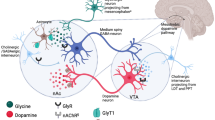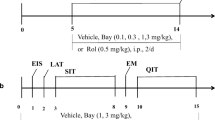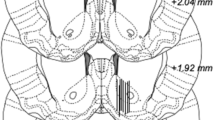Abstract
The time course of the benzodiazepine (BDZ) inverse agonist RO19-4603 in antagonizing ethanol (EtOH) intake was investigated in alcohol-preferring (P) rats (n=7) maintained on 24-h continuous free-choice access to EtOH (10% v/v), water, and food. After fluid intakes had stabilized over several weeks, animals were injected with Tween-80 vehicle solution or RO19-4603 (0.075, 0.150, and 0.30 mg/kg). EtOH and water intakes were determined at 8- and 24-h intervals. RO19-4603 caused a marked attenuation of EtOH drinking with each of the doses tested. EtOH intake during the 8-h following 0.075, 0.150, and 0.30 mg/kg RO19-4603 was decreased by approximately 36, 74, and 57%, respectively. Intakes during the 24-h interval were similar to the vehicle control condition. However, 32 h post-drug administration, EtOH intakes were reduced to approximately 27, 31, and 29% following the 0.075, 0.150 and 0.30 mg/kg doses, respectively. To further confirm the reliability of the RO19-4603 dose-response effect, and its selectivity for EtOH, the highest dose condition (0.30 mg/kg) was tested twice. The second 0.30 mg/kg dose condition exerted a profile of effects similar to the initial treatment; 8 h following administration, intake was decreased to 60% of the control level, and 32 h post-drug administration intake was decreased to approximately 46% of the controls. These decreases were evidently selective in comparison with water, since water drinking showed compensatory increases which paralleled the decreased EtOH consumption. Dose-response comparisons indicated that 0.150 mg/kg approaches the maximum effective dose, since the 0.30 mg/kg dose of RO19-4603 did not produce an additional decrease in EtOH intake. Furthermore, unlike the lower doses, the 0.30 mg/kg dose failed to yield reliable compensatory increases in water drinking. The results demonstrated that a single acute administration of RO19-4603 produces prolonged and selective suppression of EtOH intake in P rats maintained on 24-h continuous free access to EtOH. While it is not clear at present what properties of the ligand might explain the observed effects on EtOH intake, these findings along with our previous work, clearly suggest that RO19-4603 may modify neuronal processes that promote EtOH self-administration. Neural transmission at the GABAA-BDZ receptor complex may play an important role in mediating EtOH reinforcement.
Similar content being viewed by others
References
Baldwin HA, Wall TL, Schuckit MA, Koob GF (1990) Differential effects of ethanol on punished responding in the P and NP rats. Alcohol Clin Exp Res 15:700–704
Belzung C, Misslin R, Vogel E (1990) Anxiogenic effects of a benzodiazepine receptor partial inverse agonist, RO19-4603, in a light/dark choice situation. Pharmacol Biochem Behav 36:593–596
Brown ZW, Gill K, Abitbol M, Amit Z (1982) Lack of effect of dopamine receptor blockade on voluntary ethanol consumption in rats. Behav Neurol Biol 36:291–294
Buck KI, Harris RA (1990) Benzodiazepine agonist and inverse agonist actions on GABAA receptor-operated chloride channels. I. Acute effect of ethanol. J Pharmacol Exp Ther 253:706–712
Cappell H, Herman CP (1972) Alcohol and tension reduction. A review. Q J Stud Alcohol 33:33–64
Deutsch JA, Walton NY, Theil TR (1978) The importance of postingestional factors in limiting alcohol consumption in the rat. Behav Biol 22:128–131
Froehlich JC, Harts J, Lumeng L, Li T-K (1988) Differences in response to the aversive properties of ethanol in rats selectively bred for oral ethanol preference. Pharmacol Biochem Behav 31:215–222
Fuxe K, Agnati LF, Bolme P, Hokfelt T, Lidbrink P, Ljungdahl A, Perez da la Mora M, Orgen S (1975) The possible involvement of GABA mechanisms in the action of benzodiazepines on central catecholamine neurons. In: Costa E, Greengard P (eds) Mechanisms of action of benzodiazepines. Raven Press, New York, pp 67–94
Gatto GJ, Murphy JM, Waller MB, McBride WJ, Lumeng L, Li T-K (1987) Chronic ethanol tolerance through free choice drinking in the P line of alcohol preferring rats. Pharmacol Biochem Behav 28:111–115
Haefely W (1990) The GABAA-benzopdiazepine receptor: biology and pharmacology. In: Burrows GD, Roth M, Noyes Jr R (eds) Handbook of anxiety. Elsevier, Amsterdam, pp 165–188
Harris CM, Lal H (1988) Central nervous system effects of Ro15-4513. Drug Dev Res 13:187–203
Harris R (1990) Alcohol sensitivity. Nature 348:589
Hunkeler W (1988) Preclinical research findings with flumazenil (ROIS-1788, anexate): chemistry. Eur J Anesthesiology 2:37–38
June HL, Colker RE, Domangue KR, Perry LE, Hicks LH, June PL, Lewis MJ (1992) Ethanol self-administration in deprived rats: effects of RO15-4513 alone, and in combination with flumazenil (Ro15-1788). Alcohol Clin Exp Res 16:11–16
June HL, Greene TL, Murphy JM, Lumeng L, Li T-K (1993) RO19-4603 selectively attenuates ethanol intake in the alcohol-preferring p rat. Alcohol Clin Exp Res 17:481 (abstract)
June HL, Hughes RW, Spurlock HL, Lewis MJ (1994) Effects of Ro15-4513 alone, and in combination with flumazenil (Ro15-1788) on ethanol self-administration in freely feeding and drinking rats. Psychopharmacology (in press)
Korpi ER, Uusi Oukari M (1992) Cerebellar GABAA receptors and alcohol related behaviors: focus on diazepam-insensitive [3H] Ro15-4513 binding. In: Biggio G, Concas A, Costa E (eds) GABA ergic Synaptic transmission
Lewis MJ (1990) Alcohol: Mechanisms of addiction and reinforcement. In: Erickson CK, Javors MA, Morgan WW, Stimmel B (eds) Advances in alcohol and substance abuse: addiction potential of abused drugs and drug classes, 9 (1/2). Haworth, New York, pp 47–67
Liljequist S, Engel J (1984) The effect of GABA and benzodiazepine receptor antagonists on the anti-conflict actions on diazepam or ethanol. Pharmacol Biochem Behav 21:521–525
Lister RG, Durcan MJ (1989) Antagonism of the intoxicating effects of ethanol by the potent benzodiazepine receptor ligand Ro19-4603. Brain Res 482:141–144
Lister RG, Nutt DJ (1988) Interactions of the imidazobenzodiazepine Ro15-4513 with chemical convulsants. Br J Pharmacol 93:210–214
Linesman MA (1990) Effects of dopaminergic agents on alcohol consumption by rats in a limited access paradigm. Psychopharmacology 100:195–200
Logue PE, Gentry WD, Linnoila M, Erwin CW (1978) Effect of alcohol consumption on state anxiety changes in male and female non-alcoholics. Am J Psychiatry 135:1079–1081
Luddens H, Pritchett DB, Kohler M Killisch I, Keinanen K, Monyer H, Sprengel R, Seeburg PH (1990) Cerebellar GABAA receptor selective for a behavioral alcohol antagonist. Nature 346:648–651
Lynes WH, Smith FL (1992) Influence of dopaminergic and serotonergic neurons on intravenous ethanol self-administration in the rat. Pharmacol Biochem Behav 42:187–192
Mandema JW, Danhof M (1992) Electroencephalogram effect measures and relationships between pharmacokinetcis and pharmacodynamics of centrally acting drugs. Clin Pharmacokinet 23:191–215
Mandema JW, Kuck MT, Danhof M (1992) In vivo modeling of the pharmacodynamic interaction between benzodiazepines which differ in intrinsic efficacy. J Pharmacol Exp Ther 261:56–61
Mehta AK, Ticku MK (1988) Ethanol potentiation of GABAergic transmission in cultured spinal cord neurons involves gammaaminobutyric acidA-gated chloride channels. J Pharmacol Exp Ther 246:558–564
McBride WJ, Murphy JM, Lumeng L, Li T-K (1988) Effects of RO15-4513, fluoxetine, desipramine on the intake of ethanol, water and food by the alcohol-preferring (P) and non-preferring (NP) lines of rats. Pharmacol Biochem Behav 30:1045–1050
McBride WJ, Murphy JM, Lumeng L, Li T-K (1992) Serotonin, dopamine and GABA involvement in alcohol drinking of selectively bred rats. In: Annual review of addiction research and treatment. Pergamon, New York, pp 193–202
Middaugh, LD, Boa K, Becker HC, Daniel SS (1991) Effects of Ro15-4513 on ethanol discrimination in C57BL/mice. Pharmacol Biochem Behav 30:1045–1050
Murphy JM, Gatto GJ, Waller MB, McBride WJ, Lumeng L, Li TK (1986) Effects of scheduled access on ethanol intake by the alcohol-preferring (P) line of rats. Alohol 3:331–336
Murphy JM, Gatto GJ, McBride WJ, Lumeng L, Li T-K (1989) Operant responding for oral ethanol in the alcohol-preferring P and alcohol-nonpreferring NP lines of rats. Alcohol 16:127–131
Paul SM, Marangos PJ, Skolnick P (1981) The benzodiazepine-GABA-chloride ionophore receptor complex: common site of minor tranquilizer action. Biol Psychiatry 16:213–229
Pohorecky LA (1981) The interaction between alcohol and stress: a review. Neurosci Biobehav Rev 5:209–229
Pieri L (1988) Ro19-4603: a benzodiazepine receptor partial inverse agonist with prolonged proconvulsant action in rodents. Br J Pharmacol 95:477 (abstract)
Pieri L, Biry P, Wdonwicki G (1985) A novel benzodiazepine receptor partial inverse agonist Ro15-3505. Br J Pharmacol 86:592
Rassnick S, D'Amico E, Riley E, Koob GF (1993) GABA antagonist and benzodiazepine partial inverse agonist reduce motivated responding for ethanol. Alcohol Clin Exp Res 17:124–130
Richards G, Schoch P, Jenck F (1991) Benzodiazepine receptors and their ligands. In: Rodgers, RJ, Cooper SJ (eds) 5-HT1A agonists, 5-HT3 antagonists and benzodiazepines: their comparative behavioral pharmacology. Raven Press, New York, pp 20–22
Samson HH, Haraguchi M, Tolliver GA, Sadeghi KG (1989) Antagonism of ethanol-reinforced behavior by the benzodiazepine inverse agonists Ro15-4513 and FG7142: relationship to sucrose reinforcement. Pharmacol Biochem Behav 33:601–608
Scheel-Kruger J (1986) Dopamine-GABA interactions: Evidence that GABA transmits, modulates and mediates dopaminergic functions in basal ganglia and the limbic system. Acta Neurol Scand 73:[Suppl 107], 1–54
Schuckit MA, Engstrom D, Alpert R, Duby J (1981) Differences in muscle tension response to ethanol in young men with and without family histories of alcoholism. J Stud Alcohol 42:918–924
Seighart W, Eichinger A, Richards JG, Mohler H (1987). Photo affinity labelling of benzodiazepine receptor proteins with the partial inverse [3H] Ro15-4513: A biochemical and autoradiographic study. J Neurochem 48:46–52
Stewart RB, Gatto GJ, Lumeng L, Li TK, Murphy JM (1993) Comparison of alcohol-preferring (p) and non-preferring (np) rat on tests of anxiety and for the anxiolytic effects of ethanol. Alcohol 10:1–10
Suzdak PD, Glowa JR, Crawley JN, Schwartz RD, Skolnick P, Paul SM (1986) A selective imidazobenzodiazepine antagonist of ethanol in the rat. Science 234:1243–1247
Suzdak PD, Paul SM, Crawley JN (1988) Effects of Ro15-4513 and other benzodiazepine receptor inverse agonists on alcohol-induced intoxication in the rat. J Pharmacol Exp Ther 245:880–886
Turner DM, Sapp DW, Olsen, RW (1991) The benzodiazepine/alcohol antagonist Ro15-4513: binding to a GABAA receptor subtype that is insensitive to diazepam. J Pharmacol Exp Ther 257:1236–1242
Uusi-Oukari M, Korpi ER (1990) Diazepam sensitivity of the binding of an imidazobenzodiazepine, [3H] Ro15-4513, in cerebellar membranes from two rat lines developed for high and low alcohol sensitivity. J Neurochem 54:1980–1987
Waller MB, McBride WJ, Lumeng L, Li T-K (1982) Induction of dependence on ethanol by free-choice drinking in alcohol-preferring rats. Pharmacol Biochem Behav 16:501–507
Waller MB, McBride WJ, Lumeng L, Li T-K (1983) Initial sensitivity and acute tolerance to ethanol in P and NP lines of rats. Pharmacol Biochem Behav 19:683–686
Waller MB, McBride WJ, Gatto GJ, Lumeng L, Li T-K (1984) Intragastric self-infusion of ethanol by ethanol preferring and non-preferring lines of rats. Science 225:78–80
Weiss F, Koob GF (1991) Neuropharmacology of ethanol. In: Myers RE, Koob GF, Lewis MJ, Paul SM (eds) Neuropharmacology of ethanol. Birkhauser, Boston, pp 49–76
Wong G, Skolnick P (1992) High affinity ligands for “diazepam-insensitive” benzodiazepine receptors. Eur J Pharmacol 225:63–68
Zormuski CF, Isenberg KE (1991) Insights into the structure and function of GABA-benzodiazepine receptors: ion channels and psychiatry. Am J Psychiatry 148:2
Author information
Authors and Affiliations
Rights and permissions
About this article
Cite this article
June, H.L., Murphy, J.M., Mellor-Burke, J.J. et al. The benzodiazepine inverse agonist RO19-4603 exerts prolonged and selective suppression of ethanol intake in alcohol-preferring (P) rats. Psychopharmacology 115, 325–331 (1994). https://doi.org/10.1007/BF02245073
Received:
Revised:
Issue Date:
DOI: https://doi.org/10.1007/BF02245073




